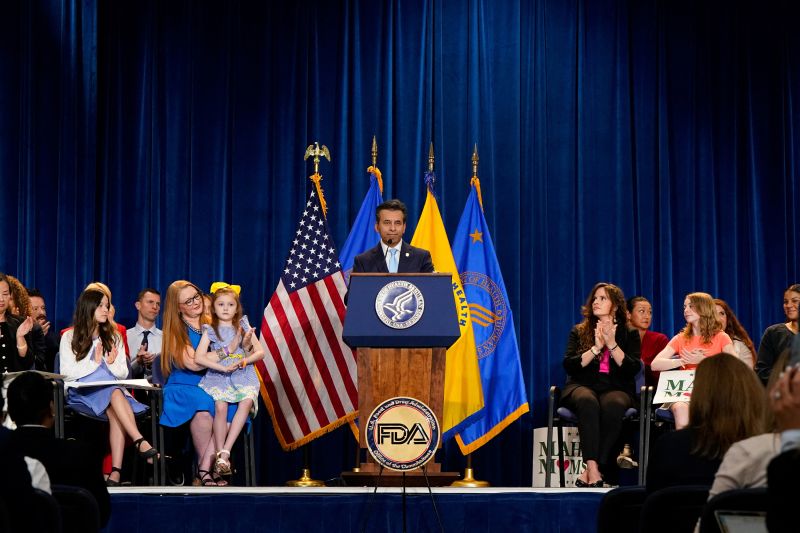The US Food and Drug Administration plans to phase out the use of petroleum-based synthetic dyes in the US food supply due to health concerns, Commissioner Dr. Marty Makary announced Tuesday.
“For the last 50 years, American children have increasingly been living in a toxic soup of synthetic chemicals,” Makary said. “Now, there’s no one ingredient that accounts for the child chronic disease epidemic, and let’s be honest, taking petroleum-based food dyes out of the food supply is not a silver bullet that will instantly make America’s children healthy, but it is one important step.”
The dyes can be found in many candies, cereals, beverages and even in some medication. Companies use the dyes to give food and drinks brighter colors and make them more appealing.
Makary emphasized that this effort to eliminate dyes will be done by working with, rather than against, the industry.
“There are a number of tools at our disposal. And so I believe in love, and let’s start in a friendly way and see if we can do this without any statutory or regulatory changes, but we are exploring every tool in the toolbox to make sure this gets done very quickly,” he said. “They want to do it. So why go down a complicated road with Congress when they want to do this? They don’t want to deal with a patchwork of 30 different state plans.”
The Consumer Brands Association, a trade association for the makers of consumer packaged goods, said that ingredients in the US food supply have been “rigorously studied following an objective science and risk-based evaluation process and have been demonstrated to be safe.”
“As we increase the use of alternative ingredients, food and beverage companies will not sacrifice science or the safety of our products,” Melissa Hockstad, the group’s president and CEO, said in a statement.
Which dyes carry risk to human health and at what level is unclear. Historically, research on food dyes has been underfunded, and the FDA hasn’t thoroughly reviewed food dyes for decades experts say. Some studies show that dyes can pass through the human body quickly, but others show that they may accumulate over time.
For decades, research in animals has shown a potential link between artificial food dyes like red No. 3, red No. 40, blue No. 2 and green No. 3 and an increased risk of cancer or tumors. Other research shows that red No. 40 and yellow No. 5 and No. 6 contain or may be contaminated with known carcinogens.
Blue No. 1 and yellow No. 6 may be toxic to some human cells, and as little as 1 milligram of yellow No. 5 may cause irritability, restlessness and sleep disturbances for sensitive children. Some research has also shown connections between artificial food dyes and restlessness, trouble learning and attention problems in some children who are sensitive to some dyes.
In January, under the Biden administration, the FDA announced that it had banned the use of red dye No. 3 in ingested drugs, food and beverages.
On Tuesday, Makary said the agency is requesting that food companies move up the deadline on that ban from the previous 2027-28 deadline. He also said it is establishing a national standard and timeline for the food industry to transition from petroleum-based food dyes to natural alternatives.
The FDA said it is initiating a process to revoke the authorization of synthetic food colorings, including those not in production – specifically citrus red No. 2 and orange B – within the coming weeks.
The FDA is also taking steps to work with industry to eliminate six synthetic dyes – red No. 40, yellow No. 5, yellow No. 6, blue No. 1, blue No. 2 and green No. 3 – by the end of next year.
“The FDA is effectively removing all petroleum-based food dyes from the US food supply,” Makary said. “Today’s announcement fulfills the administration’s promise to use both gold standard science and common sense. For the last 50 years, we have been running one of the largest uncontrolled scientific experiments in the world on our nation’s children without their consent, and today we are removing these petroleum-based chemicals from their food supply.”
The FDA also said it will authorize four new natural color additives in the coming weeks and fast-track the review of natural alternatives to synthetic food dyes such as calcium phosphate, Galdieria extract blue, gardenia blue and butterfly pea flower extract.
The National Confectioners Association said it “looks forward to working with the Trump Administration and Congress on the issue.”
“FDA and regulatory bodies around the world have deemed our products and ingredients safe,” Christopher Gindlesperger, senior vice president for public affairs and communications, said in a statement. “We follow and will continue to follow regulatory guidance from the authorities in this space, because consumer safety is our chief responsibility and priority.”
Consumer Reports, a consumer safety group, said the goal is “laudable” but will take “years to achieve” since it’s relying on the goodwill of the food industry.
“It’s encouraging to see the FDA working towards a ban on synthetic food dyes, but this multistep plan relies on voluntary industry efforts that will simply prolong the amount of time it will take to get dangerous dyes out of our food,” said Brian Ronholm, the group’s director of food policy.
The agency says it will offer some regulatory flexibility to the industry and will partner with the National Institutes of Health to do more research on food additives to determine their effects on children’s health.
More than half of states have legislation in the works or rules in place to restrict food dyes due to a concerns about human health, according to the Environmental Working Group, a nonprofit that advocates for environmental and health policy. The industry has been advocating for a more consistent federal standard, but some consumer groups have been encouraging states to continue creating local bans.
“Consumer Brands has long asked HHS and FDA to reestablish themselves as the country’s leading regulatory authority and we appreciate that the administration has reasserted their leadership in response to the myriad of state activity in the food regulation space,” Hockstad said.
EWG says it has been asking the federal government to take action on the issue for years.
“The Food and Drug Administration has known for decades that synthetic food dyes are linked to health problems, particularly in children, but has failed to act,” Melanie Benesh, the group’s vice president for government affairs, said in an email. “We’re pleased the administration is following the lead of states like California and West Virginia by finally announcing their intent to ban dyes.”
California has long been an outlier in its actions on food dyes and other additives, and in March, West Virginia Gov. Patrick Morrisey signed one of the most sweeping dye ban bills in the country.
US Health and Human Services Secretary Robert F. Kennedy Jr. said Tuesday that removing these synthetic dyes from the food supply is a “no-brainer.”
“Nobody wants to eat petroleum,” he said.
Kennedy praised food companies for working with the Trump administration to remove the dyes. “If they want want to eat petroleum, they ought to add it themselves at home,” he said he’d told his staff. “They shouldn’t be feeding it to the rest of us.”
Correction: A previous version of this report misstated when the six synthetic dyes will be phased out.

